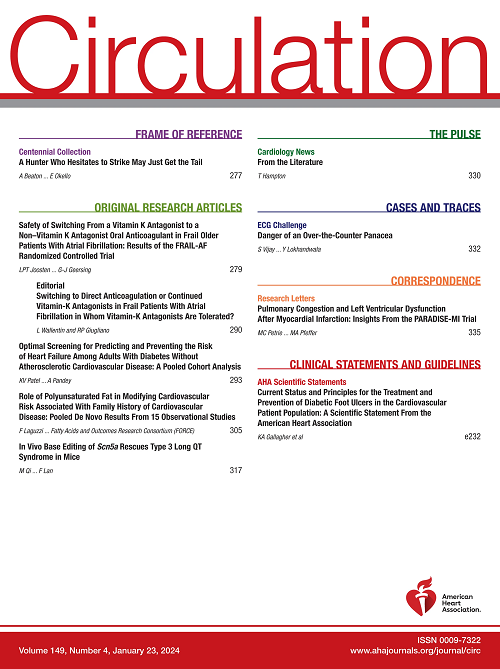Mitochondrial Tumor Suppressor 1A Attenuates Myocardial Infarction Injury by Maintaining the Coupling Between Mitochondria and Endoplasmic Reticulum.
IF 38.6
1区 医学
Q1 CARDIAC & CARDIOVASCULAR SYSTEMS
引用次数: 0
Abstract
BACKGROUND Pathological cardiac remodeling after myocardial infarction (MI) is a leading cause of heart failure and sudden death. The detailed mechanisms underlying the transition to heart failure after MI are not fully understood. Disruptions in the endoplasmic reticulum (ER)-mitochondria connectivity, along with mitochondrial dysfunction, are substantial contributors to this remodeling process. In this study, we aimed to explore the impact of mitochondrial tumor suppressor 1A (Mtus1A) on cardiac remodeling subsequent to MI and elucidate its regulatory role in ER-mitochondria interactions. METHODS Single-nucleus RNA sequencing analysis was performed to delineate the expression patterns of Mtus1 in human cardiomyocytes under ischemic stress. MI models were induced in mice by left coronary artery ligation and replicated in vitro using primary neonatal rat ventricular myocytes exposed to oxygen glucose deprivation. Cardiac-specific deletion of Mtus1 was achieved by crossing floxed Mtus1 mice with the Myh6-MerCreMer mice. The impact of Mtus1A, a mitochondrial isoform of Mtus1, on cardiac function and the molecular mechanisms were investigated in both in vivo and in vitro settings. Mitochondria-associated ER membranes coupling levels were evaluated by transmission electron microscopy and live-cell imaging. Protein interactions involving Mtus1A were explored through immunoprecipitation-mass spectrometry, coimmunoprecipitation, and proximity ligation assay. The roles of Mtus1A and Fbxo7 (F-box protein 7) were validated in a murine MI model using adeno-associated virus serotype 9 (AAV9). RESULTS Bioinformatics analysis revealed a significant downregulation of Mtus1 expression in human cardiomyocytes under ischemic conditions, indicating its potential role in stress response. The predominant isoform in murine cardiomyocytes, Mtus1A, showed reduced expression in the left ventricle of mice after MI, which is consistent with the decreased levels of its orthologs in heart tissues from patients with MI. Cardiac-specific knockout of Mtus1 in mice exacerbated cardiac dysfunction after MI. Both in vitro and in vivo studies demonstrated the vital role of Mtus1A in modulating mitochondria-associated ER membranes coupling and preserving mitochondrial function. Mechanistically, Mtus1A functions as a scaffold protein that maintains the formation of inositol 1,4,5-trisphosphate receptor 1 (IP3R1)-glucose-regulated protein 75 (Grp75)-voltage-dependent anion channel 1 (VDAC1) complex through its amino acid sequence 189-219. In addition, Mtus1A protein is stabilized by K6-linked ubiquitination through the E3 ubiquitin ligase Fbxo7. Mtus1A overexpression in mice mitigated MI-induced cardiac dysfunction and remodeling by maintaining ER-mitochondria connectivity. CONCLUSIONS Our study demonstrates that Mtus1A is crucial for modulating MI-induced cardiac remodeling by preserving ER-mitochondria communication and ameliorating mitochondrial function in cardiomyocytes. Mtus1A may serve as a potential therapeutic target for treating heart failure after MI.线粒体肿瘤抑制因子1A通过维持线粒体和内质网之间的偶联减轻心肌梗死损伤。
背景:心肌梗死(MI)后的病理性心脏重构是心力衰竭和猝死的主要原因。心肌梗死后转变为心力衰竭的详细机制尚不完全清楚。内质网(ER)-线粒体连通性的破坏,以及线粒体功能障碍,是这种重塑过程的重要贡献者。在本研究中,我们旨在探讨线粒体肿瘤抑制因子1A (Mtus1A)对心肌梗死后心脏重塑的影响,并阐明其在er -线粒体相互作用中的调节作用。方法采用单核RNA测序方法,研究缺血应激下心肌细胞中Mtus1的表达模式。采用左冠状动脉结扎法诱导小鼠心肌梗死模型,并利用缺氧缺氧的新生大鼠心室肌细胞体外复制心肌梗死模型。通过将固定的Mtus1小鼠与Myh6-MerCreMer小鼠杂交,实现了心脏特异性的Mtus1缺失。在体内和体外环境下,研究了Mtus1的线粒体亚型Mtus1A对心功能的影响及其分子机制。通过透射电镜和活细胞成像评估线粒体相关内质网膜偶联水平。通过免疫沉淀-质谱法、共免疫沉淀和近端结扎法研究了涉及Mtus1A的蛋白质相互作用。使用腺相关病毒血清型9 (AAV9)在小鼠心肌梗死模型中验证了Mtus1A和Fbxo7 (F-box蛋白7)的作用。结果生物信息学分析显示,缺血状态下人心肌细胞中Mtus1表达显著下调,提示其在应激反应中发挥潜在作用。小鼠心肌细胞中主要的同种异构体Mtus1A在心肌梗死后小鼠左心室中的表达减少,这与心肌梗死患者心脏组织中其同源物的水平下降是一致的。小鼠心脏特异性敲除Mtus1会加剧心肌梗死后的心功能障碍。体外和体内研究都证明了Mtus1A在调节线粒体相关内质网膜偶联和保持线粒体功能方面的重要作用。机制上,Mtus1A作为支架蛋白,通过其氨基酸序列189-219维持肌醇1,4,5-三磷酸受体1 (IP3R1)-葡萄糖调节蛋白75 (Grp75)-电压依赖性阴离子通道1 (VDAC1)复合物的形成。此外,通过E3泛素连接酶Fbxo7, k6连接的泛素化可以稳定Mtus1A蛋白。小鼠中Mtus1A过表达通过维持er -线粒体连通性减轻了心肌梗死诱导的心功能障碍和重塑。结论我们的研究表明,Mtus1A在心肌细胞中通过维持er -线粒体通讯和改善线粒体功能来调节心肌梗死诱导的心脏重构中起着至关重要的作用。Mtus1A可能作为治疗心肌梗死后心力衰竭的潜在治疗靶点。
本文章由计算机程序翻译,如有差异,请以英文原文为准。
求助全文
约1分钟内获得全文
求助全文
来源期刊

Circulation
医学-外周血管病
CiteScore
45.70
自引率
2.10%
发文量
1473
审稿时长
2 months
期刊介绍:
Circulation is a platform that publishes a diverse range of content related to cardiovascular health and disease. This includes original research manuscripts, review articles, and other contributions spanning observational studies, clinical trials, epidemiology, health services, outcomes studies, and advancements in basic and translational research. The journal serves as a vital resource for professionals and researchers in the field of cardiovascular health, providing a comprehensive platform for disseminating knowledge and fostering advancements in the understanding and management of cardiovascular issues.
 求助内容:
求助内容: 应助结果提醒方式:
应助结果提醒方式:


